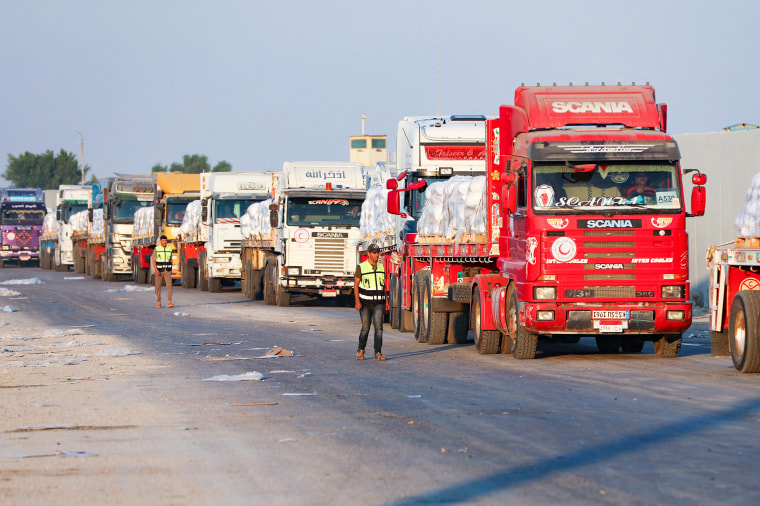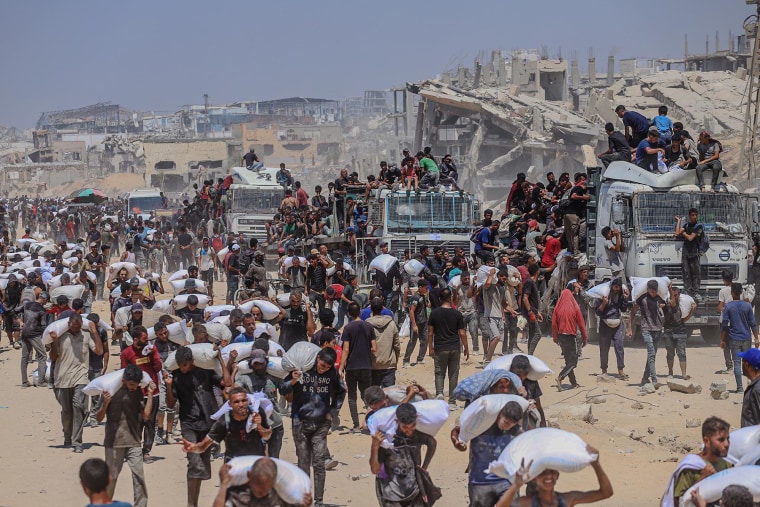Israel announced last Sunday it would pause military activity in some areas to allow more aid into Gaza following international outrage over widespread starvation and deaths from malnutrition caused by the Israeli military’s offensive and aid restrictions.
But humanitarian organizations say the amount of aid that has entered the enclave is not enough, and without more food, growing numbers of Palestinians will die from hunger.
NBC News takes a look at how much aid has entered Gaza in the week since Israel announced the new system, and how that stacks up to the needs of the population.
A tally of aid
Humanitarian aid is currently entering Gaza in three ways: airdrops, distribution by the U.S.- and Israel-backed Gaza Humanitarian Foundation, and by the United Nations and other aid organizations using the newly formed “humanitarian corridors” the Israeli military put in place last week.

The Gaza Humanitarian Foundation, which began distributing aid in the enclave in late May, has been widely condemned for the hundreds of people killed, often by Israeli soldiers, near its aid sites, and for its limited distribution.
Last Sunday, GHF distributed around 1 million meals and at least another 1.2 million from Monday to Wednesday, and 1.3 million on Thursday. GHF did not appear to publish the number of meals distributed on Friday, but on Saturday said it released at least 1.7 million meals.
In a population of roughly 2 million people, this averages out to around half a meal to just under a full meal per person per day.
COGAT, the Israeli military branch responsible for overseeing aid into Gaza, allowed an average of around just under 230 trucks into Gaza each day from last Sunday to Thursday, according to data it has published online. It says those trucks add to “hundreds” already in the enclave awaiting collection from aid groups, but has not shared the exact number. COGAT did not respond to a request for more information on the total number of trucks awaiting collection.
At least 920 aid trucks allowed into the enclave had been collected and distributed by the United Nations and other humanitarian organizations from last Sunday to Thursday, according to COGAT’s data.
Before Israel’s offensive in Gaza began, around 500 trucks carrying aid were entering Gaza daily, according to the British Red Cross and other organizations.
The below graph shows how the amount of aid entering Gaza soared during the ceasefire between Israel and Hamas, before stopping during Israel’s blockade, with only a trickle entering in the months after it was lifted.
Asked for the number of trucks allowed into Gaza and collected by humanitarian groups on Friday and Saturday, COGAT did not immediately respond.
While COGAT has shared information on trucks entering Gaza and being collected by aid groups on its social media pages over the past week, it has not updated its online dashboard on aid into Gaza since Monday, despite international focus on the matter.
According to the World Food Programme, only about two-thirds of the amount of food the U.N. organization has requested Israeli authorities allow into Gaza had been approved as of Thursday since the Israeli military began tactical pauses.
How Israeli restrictions caused the hunger crisis
The hunger crisis in Gaza drastically worsened in March after Israel imposed a blockade barring the entry of aid into Gaza, in the midst of its ceasefire with Hamas.

Israel lifted the crippling blockade in May, but for months, has only allowed a limited amount of aid to enter the enclave, most of which has been distributed by the U.S.- and Israel-backed group known as the Gaza Humanitarian Foundation.
COGAT did not immediately respond to a request for comment from NBC News on the accusation that the amount of aid entering Gaza is not enough. It has previously accused humanitarian groups, including the United Nations, of exacerbating hunger by failing to collect and distribute aid to Palestinians fast enough.
However, humanitarian organizations have said efforts to distribute the limited aid they’ve been able to get into Gaza has been hampered by Israeli restrictions. They’ve also emphasized that even after Israel vowed to lift some restrictions last Sunday, the amount of aid entering the enclave remains limited.
Meanwhile WFP has said it needs faster approvals and clearances to move trucks inside Gaza safely, as well as for Israeli military members to adhere to the “established rules of engagement,” including having no armed presence or shooting near humanitarian convoys, food distributions and operations.
What is needed?
“This is not an adequate response,” Jeanette Bailey, the International Rescue Committee’s global practice lead and director of research for nutrition, said in a phone interview on Wednesday.
A gradual entry of aid “here or there,” she said, “is not going to be adequate to prevent us from entering into a full-blown famine where the numbers of deaths go way, way up.”


